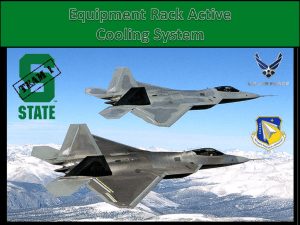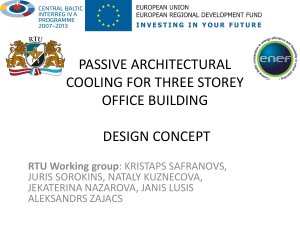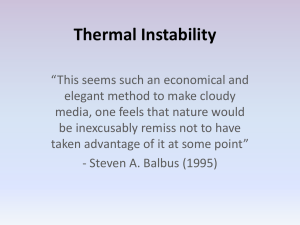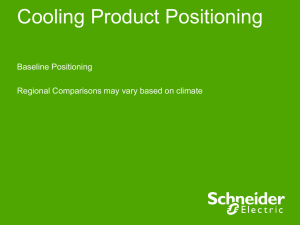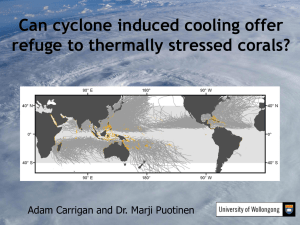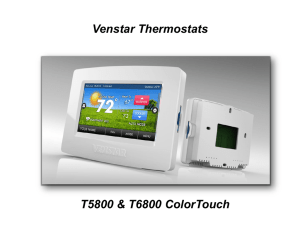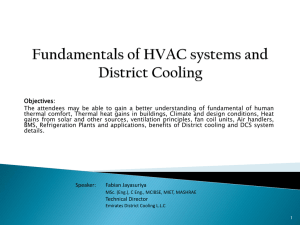Selling against Cold Aisle Containment
advertisement
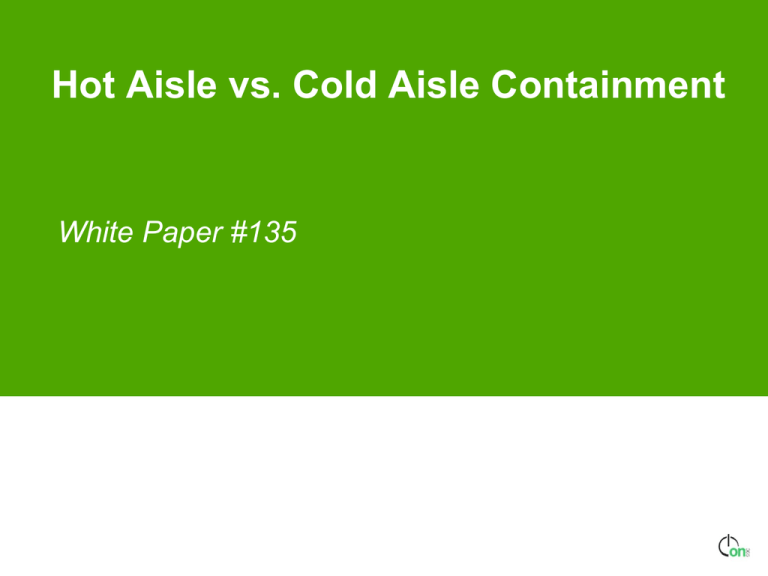
Hot Aisle vs. Cold Aisle Containment White Paper #135 Learning objectives ● Most of our competitors are promoting Cold aisle containment. The objective of the course is clearly to demonstrate the advantages of APC Infrastructure solution using Hot Aisle Containment System (HACS). ● This presentation is based on recently released White Paper #135 Agenda ● Characteristics of traditional cooling methods ● Hot Aisle Containment and Cold Aisle containment concepts ● Common advantages of both Hot Aisle Containment and Cold Aisle containment concepts ● Cold Aisle Containment system limitations ● Hot Aisle Containment system advantages ● Comparison of Hot Aisle and Cold Aisle Containment systems ● Case Study – Hot Aisle vs Cold Aisle Containment System Introduction Traditional Data Center Cooling Methods ● Traditional cooling floods the entire space and mixes hot and cold air Characteristics of Traditional Cooling ● Perimeter placed cooling units ● Raised Floor ● Hot air mixes with cold air ● Not consistent hot / cold aisle arrangement ● Oversized power and cooling components ● Low heat load densities ● Energy cost used to be low concern Present Trends ● Past practices were inefficient, costly and carbon emissions low concerned ● Row cooling and separation of hot and cold air streams are new breakthrough technologies to help to remedy the situation Hot Aisle vs. Cold Aisle Containment System Both Methodologies prevent Hot and Cold Air streams from mixing This improves predictability and efficiency of the cooling solution compare to traditional cooling Hot Aisle contains Hot Air Cold Aisle contains Cold Air Room operates as Cold air plenum Room operates as Hot air plenum (ceiling) H H (cold aisle) (floor) (plenum) In-Row Cooling Unit H CRAC C ROW ROW CRAC H H Hot Aisle vs. Cold Aisle Containment System Benefits of both Hot Aisle Containment System (HACS) and Cold Aisle Containment System (CACS) ● Prevent Hot and Cold air streams from mixing ● Cooling systems can be set to a higher temperature ● Reduction of humidification and dehumidification costs ● Better overall physical infrastructure utilization that enables rightsizing Those benefits lead to energy savings and better equipment utilization compare to traditional cooling methods Cold Aisle Containment System (CACS) Cold Aisle Containment Design ● Eliminates hot and cold air mixing ● Typically used with traditional perimeter cooling – cold air supplied via raised floor and perforated tiles. Alternatively CACS is designed with row based cooling system ● The rest of the room becomes large, return hot air plenum Cold Aisle Containment Limitations ● Perimeter Cooling – Longer air paths and higher air pressure resistance - higher power consumption by fans ● Lower return air temperature than available – lower cooling capacity and efficiency ● Limited heat load density per rack - limited by the raised floor and perforated tiles ● Limited predictability – variable room and raised floor dimensions ● Limited ride through during cooling failure - confined to Cold Aisle air volume ● Room acts as the Hot Aisle – contradicts with perception that data centers should be cold. Peoples expectation when entering the room need to be adjusted ● Room acts as the Hot Aisle – difficulty in cooling free standing racks and equipment ● Need for lower supply temperatures – higher power consumption and limiting free cooling period ● Not modular & scalable due to perimeter Cooling Hot Aisle Containment System (HACS) Hot Aisle Containment Design ● Hot Aisle Containment Concept is patented by APC (US6859366; Europe pending) ● Eliminates hot and cold air mixing ● Typically used with Row cooling – hot air is captured and neutralized via cooling units placed within the row of racks and supplied to cold aisle ● The rest of the room becomes large, cold air plenum, no raised floor or ducting is used Hot Aisle Containment Advantages ● In-Row Cooling is Closed Couple Cooling – short air paths and low air pressure resistance - lower power consumption by fans (See White Paper #130) ● Higher return air temperature – higher cooling capacity and efficiency of the cooling system ● High heat load density per rack – all heat is neutralized and there is no limitation with the raised floor and perforated tiles ● Predictable solution – independent of room and raised floor dimensions ● Higher ride through during cooling failure – significantly larger cold aisle air volume ● Room acts as the Cold Aisle – in agreement with the perception that data centers should be cold Continues.... Hot Aisle Containment System (HACS) Hot Aisle Containment Advantages ● Room acts as the Cold Aisle – flexible solution that can be deployed with existing architectures ● No need for too low supply temperatures – lower power consumption and higher potential for using free cooling and extended period of free cooling ● Modular & scalable solution due to Row cooling InRow RC Effect of increased return air temperature on sensible cooling capacity Containment Sensible Cooling Capacity (kW) 35 30 In row 25 20 15 10 5 0 72 22 80 27 85 30 90 32 9535 100 38 Return Air Temperature (°F) * APC In-row RC model air conditioner 105 41 Hot Aisle vs. Cold Aisle Containment System Fire Suppression Considerations ● Depending upon the location fire detection and/or fire suppression may be required inside the enclosed area of HACS or CACS ● The National Fire Protection Association standard NFPA75 does not state an opinion whether suppression systems (sprinklers or gaseous agents) should be provided in HACS or CACS ● NFPA 75 documents two requirements that could be applied to HACS and CACS (see White Paper #135, page 12 for details) ● HACS have been successfully installed and approved with sprinklers and gaseous agent suppression in many sites Hot Aisle vs. Cold Aisle Containment System Hot Aisle vs. Cold Aisle Containment System Hot Aisle vs Cold Aisle Containment System - Summary ● Hot Aisle and Cold Aisle Containment eliminate air mixing and it is superior solution compare to traditional cooling architecture ● Hot Aisle Containment System (HACS) is more efficient approach than Cold Aisle Containment System (CACS) because the HACS methodology allows for the channeling the hottest air directly into coolers ● HACS used with In-row cooling architecture provides closed couple cooling that allows higher cooling capacity utilization and efficiency ● HACS is more flexible, it can be deployed anywhere within the room, it is more predictable and scalable solution, it better addresses the higher IT density requirements ● HACS has higher potential for better heat utilization and using free cooling approaches ● Hot Aisle Containment has better ride through capability Case Study: Hot Aisle vs Cold Aisle Containment System ● Room size 120 m2 ● Raised floor height 1.2 m; plenum = 144 m3 ● 44 racks with 11 kW/rack => 484 kW (design load) ● Server equipment: 50% standard server; 50% blade ● Rack Air Inlet temperature = 24C ● Air turnover 108,900 m3/h (server only) ● Add 25% air turnover for raised floor ● Electrical cost 0.12 €/kWh ● Chilled water cooling system is same for both (chiller and piping) ● All calculations for N+1 CACS vs ● 8 x CRAC (Uniflair_4300A) ● Possible air flow 192,384 m3/h ● Respective power draw 32kW ● Needed air flow = 136,125 m3/h (71%) ● Needed power draw =11.3 kW (35%) ● 365 x 24 x 11.3 x 0.12 = 11,878.56 € HACS ● 18 x InRow RC ● Possible air flow 210,888 m3/h ● Respective power draw 54kW ● Needed air flow = 108,900 m3/h (52%) ● Needed power draw =7.4 kW (14%) ● 365 x 24 x 7.4 x 0.12 = 7,778.88 € •Saving HACS vs. CACS = 4,100 € per annum PLUS other benefits not calculated ● Reduced usage of free cooling when implementing CACS efficiency ↓ ● Extra cost for extra height of raised floor (effect might be minimal, though) PLUS some operational reasons ● ● ● ● Predictability of raised floor plenum is critical No standalone equipment can be placed in CACS room For partial load the power ratio gets better for HACS solution Warm air volume: CACS: 444 m3 HACS: 113m3 ● Cold air volume CACS: 180 m3 HACS: 367m3 Free Cooling – Hours/year vs Temperature CACS – Assumptions for Operation Maximum allowed ambient air temperature for (100%) FREE Cooling 8°C 17°C 11°C 30°C 31°C 24°C 32°C 32°C ∞ 29°C 11°C 20°C 17°C HACS – Assumptions for Operation Maximum allowed ambient air temperature for (100%) FREE Cooling 11°C 20°C 14°C 24°C 24°C 24°C 32°C 23°C 14°C 23°C 20°C More free cooling available with HACS ● Facts are: ● CW return temperature has to be 3°C colder than supply air temperature ● CW supply temperature has to be 3°C warmer than outside air temperature to enable 100% free cooling ● Cold air supply of downflow units supporting raised floor cooling have to be 4°C colder than the expected server inlet temperature ● Cold air supply of InRow units have to be only 1°C colder than expected server inlet temperature ● So, we calculate back from server supply temperature to be 24°C Server Inlet [°C] Cold Air Supply [°C] CW Return [°C] CW Supply [°C] Free Days Cooling Possible Temp [°C] 100% InRow 24 23 20 14 11 210 CRAC 24 20 17 11 8 160 For every day of free cooling we save another 464.64 € on the electrical bill! Savings HACS vs CACS (50 days of free cooling more) = 23,232 €/a Case Study HACS vs CACS - Summary Cost Saving Annual saving indoor units: Annual saving additional free cooling 4,100.- €/a 23,232.- €/a Total benefit for HACS over CACS Considering a life time of 10 years Savings add up to 27,332.- €/a 273,320.- € CAPEX benefit for CACS over HACS 78,160.- € Break even after 2.86 years

